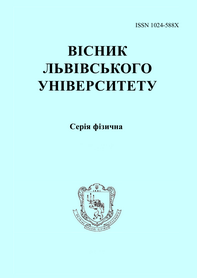Visnyk of the Lviv University. Series Physics
55 (2018) Ů. 24-39
DOI: https://doi.org/10.30970/vph.55.2018.24
—hecking of the reliability of the chemical compositions determination in planetary nebulae using diagnostic methods in combination with popular ionization-correction factors
B. Melekh, O. Khmilevska, M. Kasheba
|  |
The reliability of the chemical compositions determination in planetary nebulae (PNe) envelopes using sample of popular expressions
in combination with diagnostic methods to determine the ionic abundances on the base of diagnostic ratios between emission line intensities in spectra of these objects was checked.
For this purpose the emission-line spectra from modern grid of photoionization models of PNe were used.
This grid was calculated along the evolutionary tracks of their nuclei, with realistic radial density distribution in nebular envelope.
We used the evolutionary tracks for stars with masses which are close to Solar one (0.95M\odot, 1.00M\odot, 1.5M\odot), because most
of stars-predecessors of these nebulae have mass within this range. The correspondence of modelling results to observational data was checked
using comparison of synthetic color-color diagrams in IR (calculated in models) with observed ones.
Grid of photoionization models for PNe from Milky Way and Large Magellanic Cloud was calculated with averaged abundances of chemical elements in PNe of these galaxies.
The presence in PNe of silicate and carbonate dust grains was also taken into account.
Photoionisation modelling allow us to obtain the synthetic emission line spectra which are much more richer than observed ones.
In present work the diagnonostic of these spectra was performed using curves crossing method for ne - Te dependences. The resulting ionic abundances were used to determine the chemical abundances using sample of popular expressions from various authors.
Obtained in such way chemical abundances were compared with corresponding ones assumed during photoionization modelling.
The detailed analysis of applicability of various expressions for determining of the chemical abundances in PNe was done.
It was demonstrated the necessity of derivation of the new expressions for chemical abundances determination in envelopes of PNe using calculation results of mentioned above grid of photoionization models.
Full text (pdf)
References
- B.Y. Melekh, Visnyk Lviv Univ. Ser. Phys. 50, 125 (2015).
- V.V. Holovatyy, Fizyka svitinnya gazovykh tumannostey. Navchalnyy posibnyk (Ivan Franko National University of Lviv, Lviv, 2013), 128 p.
- D.E. Osterbrock, G.J. Ferland, Astrophysics of Gaseous Nebulae and Active Galactic Nuclei. Second Edition
- V.V. Golovatyy, R.E. Gershberg, Yu.F. Malkov, V.Y. Pronyk, Yzv. Krym. astrofyz. observatoryy. 96, 72 (1999).
- M. Seaton, MNRAS. 139, 129 (1968). doi:10.1093/mnras/139.2.129.
- P. Leisy, M. Donnefeld, Astron. Astrophys. Suppl. Ser. 116, 95 (1996).
- G. Stasinska, Astron. and Astrophys. 66, 257 (1978).
- J. Lequeux, M. Peimbert, J.F. Rayo, A Serrano, S. Torres-Peimbert, Astron. and Astrophys. 80, 155 (1979).
- G. Stasinska, Astron. and Astrophys. 84, 320 (1980).
- G. Stasinska, Astron. and Astrophys. Suppl. Ser. 48, 299 (1982).
- B. Wilkes, G. Ferland, D. Hanest, J. Truran, MNRAS. 197, 1 (1981) doi:10.1093/mnras/197.1.1.
- R.L. Kinsburg, M.J. Barlow, MNRAS. 271, 257 (1994). doi:10.1093/mnras/271.2.257.
- M. Peimbert, V. Luridiana, S. Torres-Peimbert, Rev. Mex. Astr. Astrof. 31, 147 (1995).
- T. Barker, Astropys. Journ. 267, 630 (1983). doi:10.1086/160899.
- T.X. Thuan, Y.I. Izotov, V.A. Lipovetsky, Astropys. Journ. 445, 108 (1995). doi:10.1086/175676.
- M. Peimbert, R. Costero, Bol. Obs. Ton. Tacubaga. 5, 3 (1969).
- V.V. Holovatyy, B.Ya. Melekh, M.M. Sokil, N.V. Havrylova, Astronomy Reports. 57, 366 (2013). doi:10.1134/S1063772913050041.
- V.V. Holovatyy, N.V. Havrylova, Astronomy Reports. 82, 437 (2005).
- Y. Melekh, A. Kuzmak, J. of Phys. Stud. 16, 1902 (2012).
- V.V. Holovatyy, Yu.F. Malkov, Astronomy Reports. 69, 1166 (1992).
- G.J. Ferland Hazy, A Brief Introduction to Cloudy (University of Kentucky: Physics Department Internal Report, 2008),
- A. Karska, Master thesis, Nicolaus Copernicus University, 2009.
